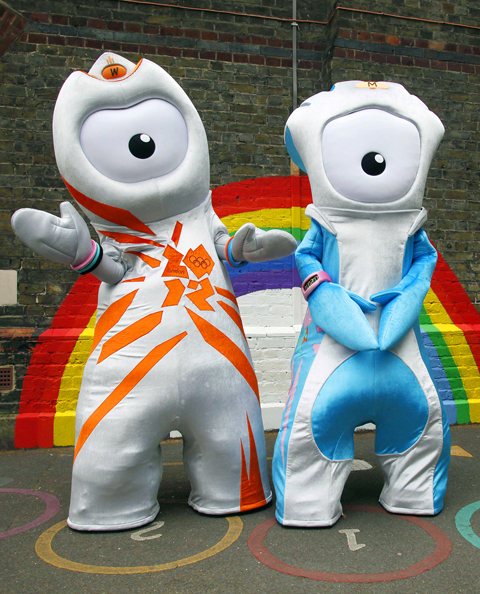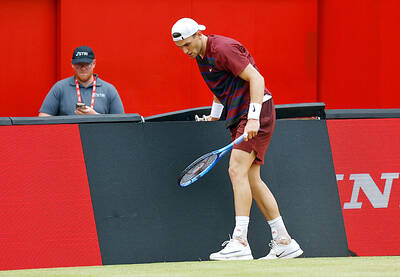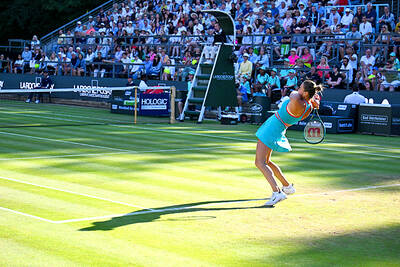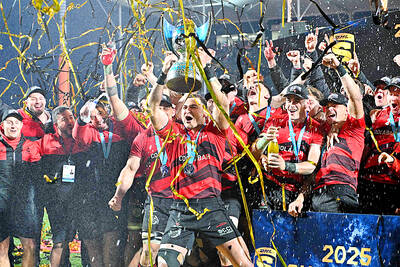Moulded from steel left over from the last girder on the Olympic stadium, London’s 2012 mascots are neither cuddly nor cute but organizers say the gleaming one-eyed metallic forms will strike a chord with children.
As the covers were removed by two pupils in front of wide-eyed classmates and Games Organizing Committee (LOCOG) chairman Sebastian Coe at an east London school a mere javelin throw from the heart of the Games, Wenlock and Mandeville were introduced to the world.
It was the culmination of an 18-month project to come up with an enduring image for the Games and a merchandising gimmick to keep the cash tills ringing as 2012 targets £16 millions (US$22.80 million) in revenue from Games memorabilia.

PHOTO: REUTERS
While modern and slightly obscure, LOCOG says the mascots recognize Britain’s Olympic heritage.
Wenlock is named after the village of Much Wenlock, where Pierre de Coubertin visited in 1890 and his idea for a modern Olympics was born. Mandeville is called after the Stoke Mandeville Hospital where the Paralympic movement began shortly after World War II.
Asked to describe exactly what his creations were, designer Grant Hunter of London-based firm Iris, said they were “magical beings” that would become “multi-dimensional” mascots aimed at capturing the imagination of children worldwide.
A group of invited journalists were given a sneak preview of an animated film based on a story by award-winning children’s author Michael Morpurgo who was commissioned by London 2012.
It showed the two steel nuggets being sculpted by the grandfather and how they spring to life in the hands of two children before morphing into various sporting poses.
The film was screened by the BBC’s One Show later on Wednesday, the official launch of the mascots 2012 chiefs hope will rank favorably alongside the likes of Moscow’s Misha, Barcelona’s Cubist-inspired Cobi and Atlanta’s unpopular Izzy.
Rather hard to describe, Wenlock and Mandeville both have one large eye, representing a camera lens so they can record what they see, cannot speak, do not smile and have features borrowed from London’s iconic taxis.
“The mascot will help us engage with children, which is what I believe passionately in,” Coe said as human-sized versions of the mascots danced in the school playground.
“The message we were getting was that children didn’t want fluffy toys, they didn’t want them to be human but thy did want them rooted in an interesting story. By linking young people to the values of sport, Wenlock and Mandeville will help inspire kids to strive to be the best they can be,” he said.
After the furor over their controversial logo in 2007, a project that cost £400,000 and was initially met with scorn before proving popular, London 2012 organizers are confident that the choice of mascots will hit the spot.
The budget was just “a few thousand,” a LOCOG official said.
“These guys will tell a story about the Olympics Games and really fit with our whole philosophy of the Games,” LOCOG chief executive Paul Deighton said, adding that some of the rejected designs included pigeons and Big Ben with legs sticking out.
To appeal to a generation of children brought up with electronic gizmos, Wenlock and Mandeville look as though they are related to computer game character Sonic the Hedgehog and will have their own place on Facebook and Twitter.

While British star Jack Draper spent the past week trying to find rhythm and comfort in his first grass tournament of the season at the Queen’s Club Championships in London, Jiri Lehecka on Saturday bulldozed everything in his path. After more than two furious hours of battle, their form was reflected in the final scoreline as Lehecka toppled a frustrated Draper, the second seed, 6-4, 4-6, 7-5 to reach the biggest final of his career, against Carlos Alcaraz. Lehecka is also the first Czech to reach the men’s title match at Queen’s since Ivan Lendl lifted the trophy in 1990. Draper, who

Top-ranked Aryna Sabalenka staged a “crazy comeback,” saving four match points before beating Elena Rybakina 7-6 (6), 3-6, 7-6 (6) in the quarter-finals of the Berlin Open on Friday. Sabalenka was 6-2 down in the final-set tie-breaker, but won six straight points to reach her eighth semi-final of the season. “Elena is a great player and we’ve had a lot of tough battles,” Sabalenka said. “I have no idea how I was able to win those last points. I think I just got lucky.” “I remember a long time ago when I was just starting, I won a lot of matches being down

The Canterbury Crusaders edged the Waikato Chiefs 16-12 in an intense Super Rugby Pacific final battle in Christchurch yesterday to claim their 15th title in 30 years of the Southern Hemisphere competition. Hooker Codie Taylor scored a try and Rivez Reihana contributed 11 points from the kicking tee as the most dominant team in Super Rugby history extended their perfect home playoff record to 32 successive matches since 1998. The Chiefs, who were looking for a first title since 2013, scored first-half tries through George Dyer and Shaun Stevenson, but were unable to register a point after the break and fell to

REUNION: Former Barcelona players Luis Suarez, Lionel Messi, Sergio Busquets, Jordi Alba and Miami coach Javier Mascherano are to face their former coach Luis Enrique Inter Miami’s Lionel Messi faces a tantalizing reunion with former club Paris Saint-Germain in the FIFA Club World Cup last 16 after both sides on Monday progressed to the knockout phase. Miami drew 2-2 with Palmeiras to go through second in Group A, after the Brazilian side fought back from two goals down to seal top spot. They now face an all-Brazil clash against Botafogo, who lost 1-0 to Atletico Madrid, but progressed from Group B in second at the expense of the Spaniards. Champions of Europe PSG won the group with a 2-0 victory over Seattle Sounders, paving the